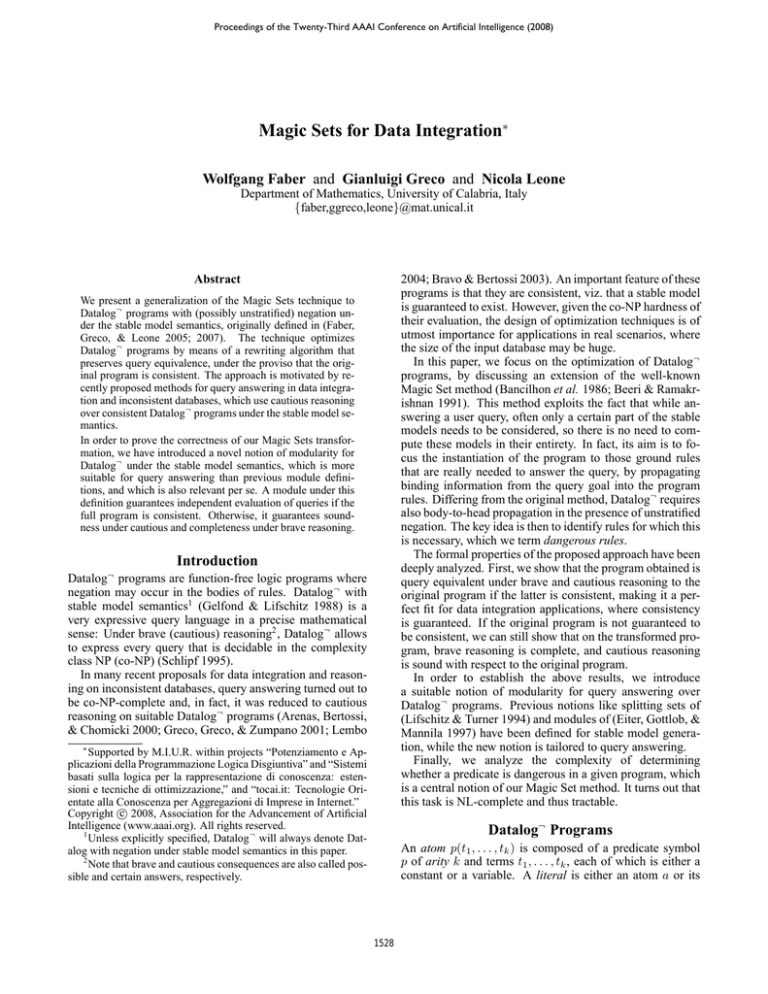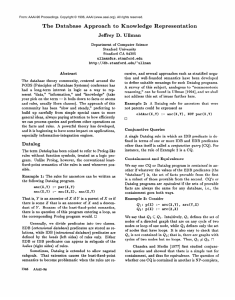
Proceedings of the Twenty-Third AAAI Conference on Artificial Intelligence (2008)
Magic Sets for Data Integration∗
Wolfgang Faber and Gianluigi Greco and Nicola Leone
Department of Mathematics, University of Calabria, Italy
{faber,ggreco,leone}@mat.unical.it
Abstract
2004; Bravo & Bertossi 2003). An important feature of these
programs is that they are consistent, viz. that a stable model
is guaranteed to exist. However, given the co-NP hardness of
their evaluation, the design of optimization techniques is of
utmost importance for applications in real scenarios, where
the size of the input database may be huge.
In this paper, we focus on the optimization of Datalog¬
programs, by discussing an extension of the well-known
Magic Set method (Bancilhon et al. 1986; Beeri & Ramakrishnan 1991). This method exploits the fact that while answering a user query, often only a certain part of the stable
models needs to be considered, so there is no need to compute these models in their entirety. In fact, its aim is to focus the instantiation of the program to those ground rules
that are really needed to answer the query, by propagating
binding information from the query goal into the program
rules. Differing from the original method, Datalog¬ requires
also body-to-head propagation in the presence of unstratified
negation. The key idea is then to identify rules for which this
is necessary, which we term dangerous rules.
The formal properties of the proposed approach have been
deeply analyzed. First, we show that the program obtained is
query equivalent under brave and cautious reasoning to the
original program if the latter is consistent, making it a perfect fit for data integration applications, where consistency
is guaranteed. If the original program is not guaranteed to
be consistent, we can still show that on the transformed program, brave reasoning is complete, and cautious reasoning
is sound with respect to the original program.
In order to establish the above results, we introduce
a suitable notion of modularity for query answering over
Datalog¬ programs. Previous notions like splitting sets of
(Lifschitz & Turner 1994) and modules of (Eiter, Gottlob, &
Mannila 1997) have been defined for stable model generation, while the new notion is tailored to query answering.
Finally, we analyze the complexity of determining
whether a predicate is dangerous in a given program, which
is a central notion of our Magic Set method. It turns out that
this task is NL-complete and thus tractable.
We present a generalization of the Magic Sets technique to
Datalog¬ programs with (possibly unstratified) negation under the stable model semantics, originally defined in (Faber,
Greco, & Leone 2005; 2007). The technique optimizes
Datalog¬ programs by means of a rewriting algorithm that
preserves query equivalence, under the proviso that the original program is consistent. The approach is motivated by recently proposed methods for query answering in data integration and inconsistent databases, which use cautious reasoning
over consistent Datalog¬ programs under the stable model semantics.
In order to prove the correctness of our Magic Sets transformation, we have introduced a novel notion of modularity for
Datalog¬ under the stable model semantics, which is more
suitable for query answering than previous module definitions, and which is also relevant per se. A module under this
definition guarantees independent evaluation of queries if the
full program is consistent. Otherwise, it guarantees soundness under cautious and completeness under brave reasoning.
Introduction
¬
Datalog programs are function-free logic programs where
negation may occur in the bodies of rules. Datalog¬ with
stable model semantics1 (Gelfond & Lifschitz 1988) is a
very expressive query language in a precise mathematical
sense: Under brave (cautious) reasoning2 , Datalog¬ allows
to express every query that is decidable in the complexity
class NP (co-NP) (Schlipf 1995).
In many recent proposals for data integration and reasoning on inconsistent databases, query answering turned out to
be co-NP-complete and, in fact, it was reduced to cautious
reasoning on suitable Datalog¬ programs (Arenas, Bertossi,
& Chomicki 2000; Greco, Greco, & Zumpano 2001; Lembo
∗
Supported by M.I.U.R. within projects “Potenziamento e Applicazioni della Programmazione Logica Disgiuntiva” and “Sistemi
basati sulla logica per la rappresentazione di conoscenza: estensioni e tecniche di ottimizzazione,” and “tocai.it: Tecnologie Orientate alla Conoscenza per Aggregazioni di Imprese in Internet.”
c 2008, Association for the Advancement of Artificial
Copyright Intelligence (www.aaai.org). All rights reserved.
1
Unless explicitly specified, Datalog¬ will always denote Datalog with negation under stable model semantics in this paper.
2
Note that brave and cautious consequences are also called possible and certain answers, respectively.
Datalog¬ Programs
An atom p(t1 , . . . , tk ) is composed of a predicate symbol
p of arity k and terms t1 , . . . , tk , each of which is either a
constant or a variable. A literal is either an atom a or its
1528
an arc is marked if a appears in B − (r). A cycle of DGP
is a sequence of nodes C = n1 , . . . , nk , such that each ni
(1 < i < k) occurs exactly once in C, n1 = nk , and each
(ni , ni+1 ) (1 ≤ i < k) is an arc in DGP . An odd cycle in
DGP is a cycle C = n1 , . . . , nk such that an odd number
of the arcs (ni , ni+1 ) (1 ≤ i < k) is marked. In analogy,
one can also define the atom dependency graph DGA
P of a
ground program P, by considering atoms rather than predicates. We now use this notion to define dangerous predicates
and rules. The intuition is that dangerous predicates may inhibit a stable model.
negation not a. A (Datalog¬ ) rule r is of the form
h :- b1 , . . . , bm , not bm+1 , . . . , not bn .
(1)
where h, b1 , · · · , bn are atoms and 0 ≤ m ≤ n. The atom h
is called the head of the rule. A Datalog¬ program is a set of
Datalog¬ rules. If all defining rules of a predicate p are facts
(that is, n = m = 0), then p is an EDB predicate; otherwise
p is an IDB predicate. A set of facts for EDB predicates of
a program P is called an EDB (for P). A query Q is just an
atom.
Let the (Herbrand) universe and base for a Datalog¬ program P be denoted UP and BP , respectively. The ground
instantiation of P w.r.t. UP is denoted by Ground(P). An
interpretation is a subset of BP . A ground positive literal A
(resp. negative literal not A) is true w.r.t. I if A ∈ I (resp.
A∈
/ I); otherwise it is false. An interpretation I satisfies a
ground rule r ∈ Ground(P) if the head of r is true w.r.t. I
whenever the body of r is true w.r.t. I. An interpretation I
is a model of a Datalog¬ program P if I satisfies all rules in
Ground(P).
Each not -free program P has a least (under subset inclusion) model, which is denoted by LM(P) and is the unique
stable model of P. Given a Datalog¬ program P and an
interpretation I, the Gelfond-Lifschitz transform P I is obtained from Ground(P) by deleting all rules containing
not b where b ∈ I, and deleting all not literals in the remaining rules. The set of stable models of a Datalog¬ program P, denoted by SM(P), is the set of interpretations I,
such that I = LM(P I ).
A program P is consistent if SM(P) 6= ∅, otherwise it is
inconsistent. A program P is data consistent if PF = P ∪ F
is consistent for each EDB F.
Given a ground atom a and a Datalog¬ program P, a is
a cautious (or certain) consequence of P, denoted by P |=c
a, if ∀M ∈ SM(P) : a ∈ M; a is a brave (or possible)
consequence of P, denoted by P |=b a, if ∃M ∈ SM(P) :
a ∈ M. Given a query Q, Ans c (Q, P) denotes the set of
substitutions ϑ, such that P |=c Qϑ; Ans b (Q, P) denotes
the set of substitutions ϑ, such that P |=b Qϑ.
Let P and P ′ be Datalog¬ programs and Q be a query.
Then, P is brave-sound w.r.t. P ′ and Q, denoted P⊆bQ P ′ , if
Ans b (Q, PF ) ⊆ Ans b (Q, PF′ ) is guaranteed for each EDB
F; P is cautious-sound w.r.t. P ′ and Q, denoted P⊆cQ P ′ ,
if Ans c (Q, PF ) ⊆ Ans c (Q, PF′ ) for all F. P is bravecomplete (resp., cautious-complete) w.r.t. P ′ and Q, denoted
P⊇bQ P ′ (resp., P⊇cQ P ′ ) if Ans b (Q, PF ) ⊇ Ans b (Q, PF′ )
(resp., Ans c (Q, PF ) ⊇ Ans c (Q, PF′ )). Finally, P and
P ′ are brave-equivalent (resp., cautious-equivalent) w.r.t.
Q, denoted by P≡bQ P ′ (resp. P≡cQ P ′ ), if P⊆bQ P ′ and
P⊇bQ P ′ (resp., P⊆cQ P ′ and P⊇cQ P ′ ).
Definition 1 Let P be a program (resp., ground program),
and d be a predicate (resp., atom) of P. Then, we say that d
is dangerous if either
1. d occurs in an odd cycle of DGP (resp., DGA
P ), or
2. d occurs in the body of a rule with a dangerous head predicate (resp., atom).
A rule r is dangerous, if it contains a dangerous predicate
(resp., atom) in the head.
2
Based on this definition, we define a notion of independence for sets of atoms. These sets must be closed under
rules in the head-to-body direction and in the body-to-head
direction for dangerous rules. The defining rules of these
sets then form modules.
Definition 2 An independent atom set of a ground program
P is a set S ⊆ BP such that for each atom a ∈ S the following holds:
1. if a is the head of a rule r ∈ P then all atoms of r are in
S, and
2. if a appears in the body of a dangerous rule r ∈ P then
all atoms of r are in S.
A subset T of a program P is a module if T = {r |
the head of r is in S} for some independent atom set S. 2
These modules can be used to partially evaluate programs,
as the following results show.
Theorem 1 Let T be a module of a ground program P, then
given an arbitrary EDB F, the following holds:
1. SM(PF )/TF ⊆ SM(TF ), and
2. SM(TF ) = SM(PF )/TF , if PF is consistent.3
Corollary 2 Let T be a module of a ground program P and
F be an EDB. If PF is consistent, each stable model of PF
can be obtained by enlarging a stable model of TF .
Importantly, this also means that one obtains the same answers to a query by considering only the module in which
the query predicate is contained, under the proviso that the
original program is consistent.
Dangerous Rules and Independent Atom Sets
Theorem 3 Given query Q, which is covered by module T
of a ground program P, and an EDB F, such that PF is
consistent, then it holds that:
With every program P, we associate a marked directed
graph DGP = (N, E), called the predicate dependency
graph of P, where (i) each predicate of P is a node in N ,
and (ii) there is an arc (a, b) in E directed from node a to
node b if there is a rule r ∈ P such that two predicates a and
b of literals appear in B(r) and H(r), respectively. Such
1. Ans b (Q, TF ) = Ans b (Q, PF ), and
3
For an interpretation I and a set T of rules, I/T denotes the
restriction of I to T , precisely, I/T = I ∩ BT .
1529
2. Ans c (Q, TF ) = Ans c (Q, PF ).
Input: A Datalog¬ program P, and a query Q = g(t).
Output: The optimized program MS¬ (Q, P).
More generally, the following properties hold for query
answering:
var S: stack of adorned predicates; modifiedRules,magicRules: set of rules;
begin
Theorem 4 Given query Q, which is covered by module T
of a ground program P, it holds that:
1. T ⊇bQ P and T ⊆cQ P:
2. T ≡bQ P and T ≡cQ P, if P is data consistent.
1. modifiedRules:= ∅; magicRules:=BuildQuerySeeds(Q, S);
2. while S 6= ∅ do
Magic Sets for Datalog¬ Programs
While with the notion of dangerous rules and modules we
have an adequate means for identifying subprograms which
are sufficient to answer a query, the definitions are not constructive. For this reason we next present a generalization of
the Magic Set method for Datalog¬ programs, which effectively constructs a module for answering a given query.
The algorithm is given in Figure 1. Other than the traditional phased approach of Magic Sets, it uses a stackbased architecture, where the stack holds adorned predicates
(predicates with an associated binding pattern, viz. one of b
[bound] or f [free] for each argument). The idea is to create
so-called magic predicates, which restrict the range of constants for predicate arguments to those relevant for the query.
The relevant defining rules are then modified to include these
magic predicates. Rules which are never reached from the
query and are not dangerous will not be modified, and thus
not considered.
The algorithm begins by analyzing the binding pattern of
the query, pushing the respective adorned query predicate
onto the stack and possibly storing some fact for the associated magic predicate (via the function BuildQuerySeeds).
After this initialization, the algorithm performs several steps
for each adorned predicate by popping them from the stack
(adorned predicates are pushed on the stack only once).
In steps 4-8, the binding of pα is propagated head-to-body
in each rule r of P having an atom p(t) in the head. This
propagation works as in the standard Magic Set method for
stratified Datalog¬ programs using an appropriate sideways
information passing strategy (SIPS).
Steps 9-13 perform the propagation of the binding through each dangerous rule d in P of the form
h(th ) :- Q1 (t1 ), . . . , Qm (tm ), in which the predicate p
occurs in Qi (ti ) inside the positive or negative body.
These steps are, in fact, crucial for guaranteeing cautiouscompleteness and brave-soundness for consistent programs.
In this case, in order to simulate body-to-head propagations
and to minimize the effort of doing so, we swap head and
the matching body literal and apply the standard method
as if it was a head-to-body propagation. So, the rule
d is first replaced by an “inverted” rule ds of the form
p(ti ):-h(th ), Q1(t1 ), ..., Qi−1(ti−1 ), Qi+1(ti+1 ), ..., Qm(tm ),
which has been obtained by swapping the head atom with
the body atom (possibly occurring negated) propagating the
binding. Then, the adornment can be carried out as usual
by means of the function Adorn. Since this “inverted” rule
was not part of the original program and its only purpose
is generating binding information, it will not give rise to
a modified rule, but only to magic rules. Finally, after all
3.
pα := S.pop();
4.
for each rule r ∈ P with H(r) = p(tp ) do
5.
ra := Adorn(r,pα ,S);
6.
magicRules := magicRules
7.
modifiedRules := modifiedRules
S
Generate(ra );
S
{Modify(ra )};
8.
end for
9.
for each dangerous rule d ∈ P of the form h(th ) : − Q1 (t1 ), . . . , Qm (tm )
where Qi = p or Qi = not p do
10.
let ds be the rule p(ti ) : − h(th ), Q1 (t1 ), . . . , Qi−1 (t1 ),
Qi+1 (t1 ), . . . , Qm (tm );
11.
let da :=Adorn(ds ,pα ,S);
12.
magicRules := magicRules
13.
S
Generate(da );
end for
14. end while
15. MS¬ (Q, P):=magicRules ∪ modifiedRules;
16. return MS¬ (Q, P);
end.
Figure 1: Magic Set Algorithm for Datalog¬ Programs.
the adorned predicates have been processed the algorithm
outputs the program MS¬ (Q, P).
We would like to show that MS¬ (Q, P) forms a module of
P which covers the query predicate. There is one technical
issue, however, because the algorithm creates new symbols
(the magic predicates). This means that MS¬ (Q, P) formally
is not a subset of P and hence cannot be a module by itself.
But we can partially evaluate the program on the predicates
that were introduced during the transformation, and consider
the obtained equivalent ground program, which we can show
to be indeed a module of Ground(P). These considerations
give rise to the following central result.
Theorem 5 Let P be a Datalog¬ program, let Q be a query,
and F be an EDB. Then, the following holds:
1. MS¬ (Q, P)⊆cQ P and MS¬ (Q, P)⊇bQ P;
2. Ans b (Q, MS¬ (Q, P)F ) = Ans b (Q, PF ), if PF is consistent;
3. Ans c (Q, MS¬ (Q, P)F ) = Ans c (Q, PF ), if PF is consistent;
4. MS¬ (Q, P)≡bQ P and MS¬ (Q, P)≡cQ P, if P is data consistent.
Complexity Results
A desideratum of the Magic Set algorithm is of course that
it runs in polynomial time in terms of the input program. All
operations in the algorithm are deterministic and most are
clearly simple. Moreover, under the realistic assumption that
the maximum arity of predicates is bounded by a constant, it
is also easy to see that the number of adorned predicates is
bounded by a polynomial. There is however one step in the
1530
Conclusion
algorithm that needs clarification, the cost of determining
dangerous predicates and rules.
We have provided a brief overview of an extension of the
Magic Set method for Datalog¬ programs under the stable
model semantics. The technique guarantees query equivalence for consistent programs, which occur in applications
like data integration or querying inconsistent databases. Future work includes studying promising combinations with
works such as (Bonatti 2004).
Theorem 6 Let P be a program and d be a predicate. Then,
deciding whether d is dangerous is NL-complete.
This result is not straightforward, as deciding whether the
first condition in Def. 1 holds is NP-complete. We conclude
that the Magic Set algorithm is tractable for programs with
bounded predicate arities. We can also specify the complexity for computing the set of dangerous rules.
References
Theorem 7 Let P be a Datalog¬ program. All dangerous rules can be computed in O(|Preds(P)|3 + |P|), where
Preds(P) is the set of IDB predicates of P.
Arenas, M.; Bertossi, L. E.; and Chomicki, J. 2000. Specifying and querying database repairs using logic programs
with exceptions. In FQAS 2000, 27–41.
Bancilhon, F.; Maier, D.; Sagiv, Y.; and Ullman, J. D. 1986.
Magic Sets and Other Strange Ways to Implement Logic
Programs. In PODS’86, 1–16.
Beeri, C., and Ramakrishnan, R. 1991. On the power of
magic. JLP 10(1–4):255–259.
Bonatti, P. A. 2004. Reasoning with infinite stable models.
Artificial Intelligence 156(1):75–111.
Bravo, L., and Bertossi, L. 2003. Logic programming
for consistently querying data integration systems. In IJCAI 2003, 10–15.
Eiter, T.; Gottlob, G.; and Mannila, H. 1997. Disjunctive
Datalog. ACM TODS 22(3):364–418.
Faber, W.; Greco, G.; and Leone, N. 2005. Magic sets and
their application to data integration. In ICDT’05, LNCS
3363
Faber, W.; Greco, G.; and Leone, N. 2007. Magic Sets and
their Application to Data Integration. JCSS 73(4):584–609.
Gelfond, M., and Lifschitz, V. 1988. The Stable Model Semantics for Logic Programming. In ICLP’88, 1070–1080.
Cambridge, Mass.: MIT Press.
Greco, G.; Greco, S.; and Zumpano, E. 2001. A logic programming approach to the integration, repairing and querying of inconsistent databases. In ICLP’01, LNCS 2237
INFOMIX Project Team. 2004. Demo Scenario. Tech.
Report INFOMIX S7-1, INFOMIX Project Consortium.
http://sv.mat.unical.it/infomix.
Lembo, D.; Lenzerini, M.; and Rosati, R. 2003. Methods and techniques for query rewriting. Tech. Report D5.2,
Infomix Consortium.
Lembo, D. 2004. Dealing with Inconsistency and Incompleteness in Data Integration. Ph.D. Dissertation, Universit
di Roma “La Sapienza”.
Leone, N.; Gottlob, G.; Rosati, R.; Eiter, T.; Faber, W.;
Fink, M.; Greco, G.; Ianni, G.; Kałka, E.; Lembo, D.;
Lenzerini, M.; Lio, V.; Nowicki, B.; Ruzzi, M.; Staniszkis,
W.; and Terracina, G. 2005. The INFOMIX System for Advanced Integration of Incomplete and Inconsistent Data. In
SIGMOD 2005, 915–917. ACM Press.
Lifschitz, V., and Turner, H. 1994. Splitting a Logic Program. In ICLP’94, 23–37. MIT Press.
Schlipf, J. S. 1995. The Expressive Powers of Logic Programming Semantics. JCSS 51(1):64–86.
An Application to Data Integration
This work had been motivated by needs arising within the
project INFOMIX on data integration (Leone et al. 2005),
funded by the European Commission. Here, a fully functional data integration system has been implemented by exploiting a reduction from query answering in data integration systems to cautious reasoning over Datalog¬ programs.
Indeed, a data integration system I = hG, S, Mi (where G
is a global schema, S are source schemata and M is a mapping) together with a database D for S and a query q over
G are encoded into a Datalog¬ program Π(q, I), in a way
that cautious answers for Π(q, I) correspond to the answers
given by the data integration system, cf. (Lembo, Lenzerini,
& Rosati 2003; Lembo 2004).
The binding propagation techniques proposed in this paper can be profitably exploited to isolate the relevant part
of a database. Importantly, our optimization fits perfectly
into the data integration framework. Indeed, the looselysound semantics for data integration always guarantees the
existence of a database repair no matter of the types of constraints in Σ, provided that the schema is non-key-conflicting
(Lembo 2004). Thus, the resulting logic program is consistent and our rewriting fully preserves the original semantics
of the data-integration query, since query equivalence is ensured (Theorem 5).
Theorem 8 Let I = hG, S, Mi be a data integration system, D be a database for S, and q be a query over G. Then,
ans(q, I, D) coincides with Ans c (q, MS¬ (q, Π(q, I)) ∪ D).
In order to test the effectiveness of the Magic Set technique for query optimization in data integration systems,
we have carried out some experiments on the demonstration
scenario of the INFOMIX project, which refers to the information system of the University “La Sapienza” in Rome. A
detailed discussion of the results is available in (INFOMIX
Project Team 2004). The results confirmed that on various
practical queries the performance is considerably improved
by Magic Sets, even of order of magnitudes in some cases.
Our Magic Set technique provides benefits with respect
to two crucial parameters in INFOMIX. By limiting the
computation on the fraction of the retrieved global database
which is relevant to the query binding, it generally produces
smaller ground programs. Moreover, by disregarding mapping conflicts that are irrelevant for answering the query at
hand, it can actually give rise to exponential savings.
1531






